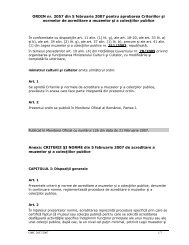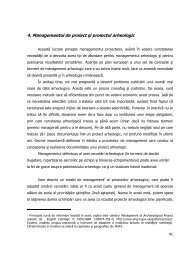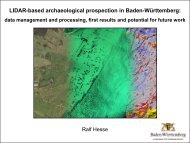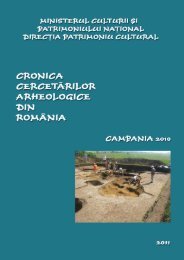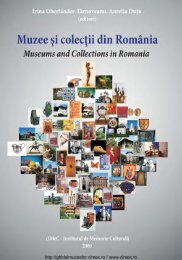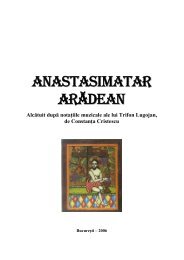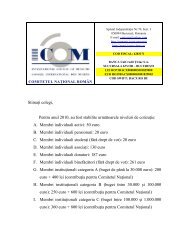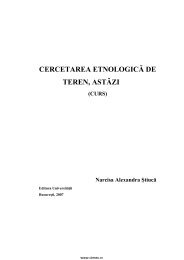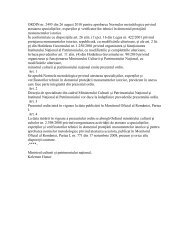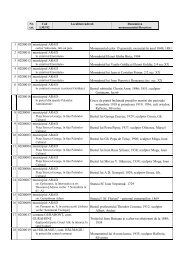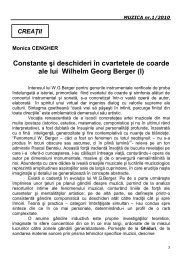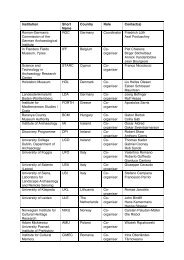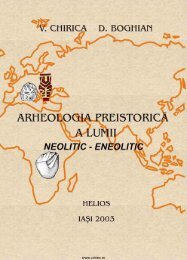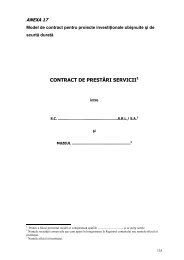pdf (15 MB) - cIMeC
pdf (15 MB) - cIMeC
pdf (15 MB) - cIMeC
You also want an ePaper? Increase the reach of your titles
YUMPU automatically turns print PDFs into web optimized ePapers that Google loves.
Cronica cercetărilor arheologice din România – campania 2006<br />
As the historical sources mentioned the presence of<br />
important Roman Period vestiges in the area, we proceeded<br />
with an extended investigation of the area.<br />
The report presents the results of the archaeological<br />
investigations of the campaign developed between 21.08 and<br />
20.10.2006. This documentation includes the results of the<br />
investigations: field investigation, description of all digging<br />
units, stratigraphy, archaeological items found and their<br />
pictures. The investigation area from 2006 campaign included<br />
the mountains Rodu and Frasin and extended to the<br />
surrounding areas, respectively Vâlcea depression and<br />
Abruzelului and Şesii valleys. The objective of the investigation<br />
team was to perform preventive investigation within this area<br />
using specific methods such as field investigations,<br />
questionnaires and digging operations.<br />
The region looks like a depression where a stream is<br />
flowing and which is surrounded by Măgura, Rodu and Frasin<br />
massifs. We investigated the region free of forest and located<br />
within the piedmont area, between the plain and compact<br />
forest covering the upper half of Rodu and Frasin massifs,. We<br />
also researched the surface which look like glades, situated on<br />
the higher area on Rodu - Dealul Băilor and on the northern<br />
hillsides of Frasin from the area known under the name Tăul<br />
Certeje.<br />
During the 2006 campaign we researched 13 surfaces<br />
belonging to 16 owners, situated at Vâlcea, Doştină, Liciu,<br />
Frasin, Mese, and Tăul Certeje. On these properties were laid<br />
out and excavated 62 archaeological sections from which: two<br />
of 7 x 4 m, one of <strong>15</strong> x 1.5 m, two of 12 x 1.5 m, one of 8 x 1.5<br />
m, two of 7.5 x 1.5 m, and others 54 of 10 x 1.5 m sizes. The<br />
excavation depth was between 0.35 and 2.20 m. The entire<br />
excavated area has 959 m 2 .<br />
Most of the investigated sections did not reveal any<br />
archaeological findings. In some cases, ceramic fragments,<br />
nail and iron pieces from the modern period were found<br />
beneath the top soil and few rolled ceramic fragments from the<br />
Roman age. Inside few sections were discovered seated stone<br />
arrangements, which were parts of the structure of some<br />
channels or water feed and direction dikes. Inside six units<br />
were found superficial stone substructure fasten to earth,<br />
belonging to a building which is dated, according to few<br />
ceramic fragments found, in modern age.<br />
We consider that the researches done during the three<br />
campaigns (2004 - 2006) on the southern and western Frasin<br />
Massive areas were conclusive contributed to ensemble image<br />
on the historical evolution in this area. By field researches we<br />
identified the already mentioned in literature area and were<br />
wrote down other points of interest, especially old mines works,<br />
both subterranean and especially at the surface. The most part<br />
of the sections did not give us archaeological information.<br />
The conclusion is that the human activities (inhabitancy or<br />
the natural depots exploitation) had a less intensity along the<br />
historical periods before modern ages. The researches done till<br />
now did not discover archaeological complexes or materials,<br />
which could indicate the existence of some human activities in<br />
pre-Roman period, but they support the idea of the presence of<br />
the Romans there. The fact that there are no kind of<br />
archaeological complexes and we discovered isolated rolled<br />
materials suggests that we do not have large human structures<br />
or economical exploitation in the area, being sporadic human<br />
activities. These conclusions, connected to casual discovery of<br />
a funerary area at the entrance of Vâlcea, on Bucium Valley,<br />
indicates the possibility that the Roman inhabitancy and<br />
necropolis could be in the area researched by us.<br />
The most part of the archaeological assemblages and<br />
materials are dated in pre-Roman, modern and contemporary<br />
periods and they might be put in connection with the<br />
inhabitancy development and especially with the identification<br />
of mining exploitation in this period. It is about a lot of dumps,<br />
channels and dikes and mire, which are the traces of human<br />
activities of exploitation and working of golden-silver ore from<br />
Rodu and Frasin massifs.<br />
39. Bucşani, com. Bucşani, jud. Giurgiu<br />
Punct: La Pod<br />
Cod sit: 101387.01<br />
Autorizaţia de cercetare arheologică sistematică nr.<br />
133/2006<br />
Colectiv: Crişan Muşeţeanu – responsabil, Cătălin Bem<br />
(MNIR), Silvia Marinescu-Bîlcu (IAB), Cătălin Nicolae<br />
(FIB), Carmen Bem, Marius Ignat (<strong>cIMeC</strong>), Andrei<br />
Mocanu, Traian Popa (MJTA Giurgiu), Adrian Bălăşescu,<br />
Constantin Haită, Valentin Radu (MNIR-CNCP), Cristina<br />
Muja (FBB), studenţi UAIC Iaşi<br />
Raport general arheologic-sedimentologic<br />
Zona noastră de interes (ceea ce am definit prin microzona<br />
Bucşani) este limitată spre S de confluenţa Neajlovului cu<br />
Dâmbovnicul, iar spre N de curba generală de nivel de 100 m.<br />
Regiunea apare geomorfologic excepţional de bine<br />
individualizată, alături de lunca şi terasele Neajlovului dintre<br />
cele două limite naturale participând la conturarea unei zone<br />
unitare şi interfluviul dintre Neajlov şi Dâmbovnic şi lunca<br />
acestuia din urmă, aprox. pe 4 km în amonte de confluenţă.<br />
Pe aprox. 8,5 km liniari de vale (în linie dreaptă), între<br />
îngustarea din nordul satului Dealu şi confluenţă (în dreptul<br />
satului Vadu Lat) lunca nu are mai mult de 1,6 km lărgime, pe<br />
alocuri aceasta nedepăşind chiar 600 m. Este singurul tronson<br />
de pe cursul mijlociu al Neajlovului care se prezintă sub<br />
această formă, fiind diferit de întregul văii din aceste<br />
perspective. Mai mult, terasele sunt relativ înalte şi abrupte,<br />
evident, procentul (chiar şi astăzi) al zonelor mlăştinoase este<br />
superior în această porţiune din vale, inundaţiile altfel îşi<br />
cuantificau consecinţele în astfel de condiţii. Caracteristicile<br />
topografice şi implicaţiile acestora au impus o anumită<br />
densitate a tell-urilor gumelniţene şi, mai ales, a evoluţiei<br />
stratigrafice şi istorice a acestora. De asemenea, nu trebuie<br />
excluse şi anumite diferenţe de mentalitate a comunităţilor din<br />
această zonă. Faptul că atât în nordul, cât mai ales în sudul<br />
zonei noastre de interes, tell-urile sunt mult mai mari în<br />
suprafaţă, mai înalte şi mult mai rare nu poate fi explicat decât<br />
prin suma caracteristicilor acesteia.<br />
În segmentul de vale individualizat (dar în care am inclus,<br />
după cum aminteam, şi interfluviul Neajlov-Dâmbovnic şi o<br />
parte a luncii acestuia din urmă) au fost descoperite 22 aşezări<br />
preistorice – două Boian-Giuleşti, 12 gumelniţene (unele având<br />
sigur un nivel superior încadrabil în ceea ce se cunoaşte<br />
despre faza B1 a culturii) şi opt din epoca bronzului (una dintre<br />
acestea părând a aparţine culturii Coslogeni).<br />
83




